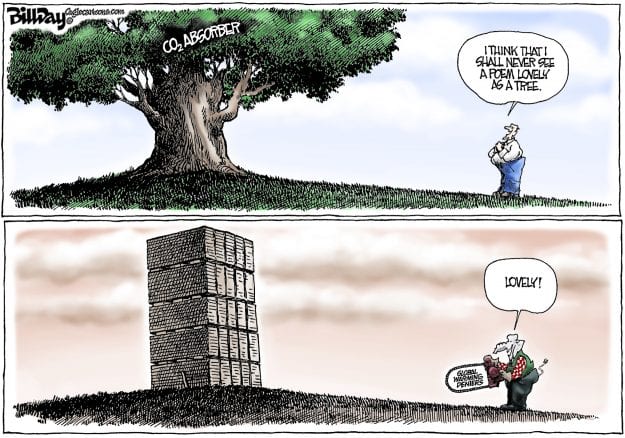BY FROMA HARROP
 The last Friday in April is National Arbor Day. You knew that, didn’t you? Born in the Victorian era, Arbor Day began mainly as a gentle reminder to admire trees as things of beauty. As an environmental observance, it has been upstaged by the more comprehensive Earth Day [itself now almost 50 years old]. But Arbor Day has been very much updated.
The last Friday in April is National Arbor Day. You knew that, didn’t you? Born in the Victorian era, Arbor Day began mainly as a gentle reminder to admire trees as things of beauty. As an environmental observance, it has been upstaged by the more comprehensive Earth Day [itself now almost 50 years old]. But Arbor Day has been very much updated.
The status of trees as uniquely important environmental players has risen in recent years. Trees are now on the front lines in the battle against climate change. That’s because forests absorb nearly 40% of human-made fossil fuel emissions every year. Burning wood and rotting trees release carbon dioxide into the air.
This makes massive deforestation a harbinger of doom for the environment as we know it. Fortunately, there are ways to head this off. Proposals to create a carbon-offset market for trees, if put in motion, could reverse the destruction. Right now, these cap-and-trade setups are open only to utilities and industrial companies. Adding trees to a cap-and-trade system would let owners of forested acres make real money by notcutting down trees.
The fate of tropical forests, particularly in Southeast Asia, is of greatest concern. The ranching, mining and timber industries have played a major role in leveling more than a billion acres of tropical forest over the last 40 years. The loss of these trees contributes an estimated 12% to 15% of the world’s carbon dioxide emissions a year.
Here’s a simplified version of how a market for trading carbon offsets now works: Company A reduces its emissions below a government-set cap. Company B’s emissions, by contrast, exceed the limit. To avoid paying a penalty, Company B buys offset credits from Company A.
The price of credits is set by supply and demand. That these systems are market-oriented pleases conservatives committed to fighting climate change. Trade in these markets already totals billions of dollars a year.
Some 40 countries now put a price on carbon. Some do it via cap-and-trade. Others, such as Canada, place a tax on fossil fuels, with most of the proceeds going back to Canadians through reductions in their tax bills. The United States does none of the above, but California and nine Northeast states have established their own cap-and-trade systems.
Where do trees come in? Removing trees increases emissions. Letting them grow reduces them. Putting a price on leaving them alone would act as a powerful incentive to not cut them down.
There remains the dilemma that many locals in and around tropical forests currently make a living in ways that require their destruction. Under a proposal known as the Rainforest Standard, however, mechanisms would be set up to spend some of the money building new livelihoods not dependent on axing trees. Examples include ecotourism, fishing and harvesting tree products, such as nuts and palm fruit.
Ordinary homeowners don’t have big forests to preserve but can nonetheless use trees to reduce their carbon footprint. Trees shading the house have a cooling effect in hot weather, reducing the need for air conditioning. And there is some money in this, of course, in the form of lower electricity bills.
So National Arbor Day is coming. Bear in mind that your state’s Arbor Day may fall on a different date than the national one. Many states move their observance to coincide with the best times in their area to plant trees. The big news this year is that in addition to providing beauty and serenity, trees can play a major role in saving our world from catastrophe. Is there a poem for that?
– Froma Harrop’s columns appear regularly in The Oklahoma Observer
Creators.com








